Replacement Engine
September, 2001
Guess what?
My replacement engine arrived today. I thought
it wouldn't arrive until after Labor Day.
I brought it home in the back of my neighbor's Volvo.
 |
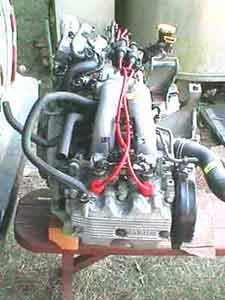 |
This one is from a manual transmission Subaru.
My original one was from an automatic. It shouldn't make any
difference.
(But it did!! Read on!)
The aluminum casting has some oxide on the surface; I think it sat in the rain for a while (it came from Portland) but I pulled the spark plugs and they look better than mine! No water in the spark plug holes although they do have caps. Looking under the timing belt cover it is very clean and no dirt or oil. The clutch and pressure plate are in very good shape. Maybe it had a clutch plate change during it's 88,000 miles of life, or, maybe not. The wiring and connector plugs look like new.
Confidence is high!!
September 1, 2001
I replace the timing belt on my new, unknown engine. The engine has 88k on it. The timing belt says Subaru on it and looks good but... timing belts are supposed to be changed at 60k. Maybe this one was, or maybe not.
 |
So, here is my new belt installed. Note the white lines on the new belt and how they are aligned. Both cam shaft belt marks are at the top and so is the crank. I started out the belt replacement by bringing everything around to this condition. Then removed the old belt and tried to not move anything while installing the new one. The tensioner had to be removed and then compressed with a bench vice. I used a small drill, inserted through the holes, to keep the tensioner compressed; installed it back on the engine and, once I was happy with the belt settings, pulled out the drill with a sharp jerk using vice grips. Perfect!
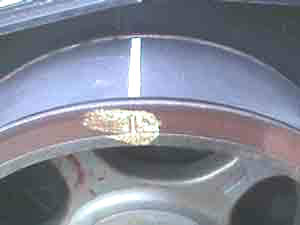 Left cam |
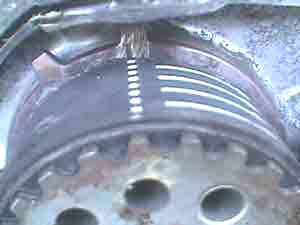 Crank |
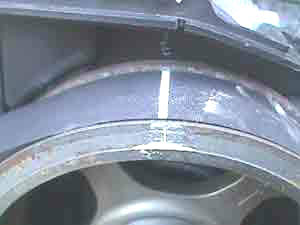 Right cam |
Here is a close up of the left cam pulley, the crank sprocket, and the right cam pulley with the marks on the belt and their relationship to the mark on the pulley's and sprocket. Both cams have marks on the front of their pulleys and the crank sprocket has a mark on the metal piece, just behind the sprocket, that gives the signal to the cam sensor.
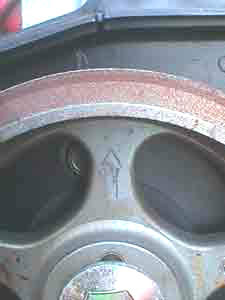 Left cam |
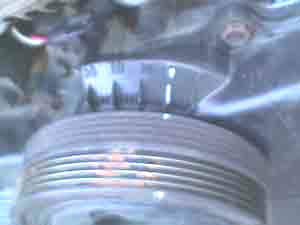 Crank |
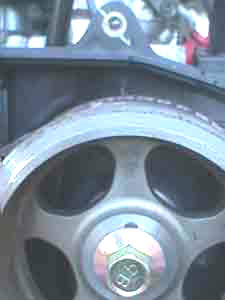 Right cam |
Okay, here I have re-installed the crank pulley and rotated the engine to bring the timing mark on the pulley up to Top Dead Center "0" on the plastic indicator. Both cam's now show the arrow, on the pulley web, pointing straight up.
I should be good to go!
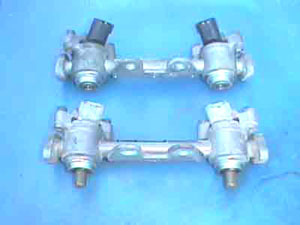 |
Here are two type of injectors for the same
year and model of Subaru.
One has a short nozzle and the other has a long one.
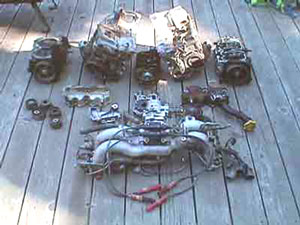 |
Here is my original 1991 Subaru engine. All except the coolant crossover pipe.
Once I had the replacement engine in the Vanagon and fired up it ran with a miss. It sounded like a valve leak. I did a compression check which showed all cylinders were within 15 psi of each other. I swapped fuel injectors from my original engine. Didn't help. I had a garage check the voltages at each injector with an oscilloscope. They all had the same duration and voltage. I was stumped.
Finally I swapped the intake, engine wiring harness, crank and cam sensors, throttle position sensor and air bypass valve over from my original engine. I started it up again and now it runs perfectly!! All I can figure is that there must have been some inconsistency between engine wiring harnesses.
Further investigation shows that one should not mix engine parts between automatic and manual transmission vehicles. If your donor car was a manual transmission type be sure to only use parts from another manual vehicle.
March 9, 2002
I have put 7,273 miles on the replacement engine so far.
Life is good.